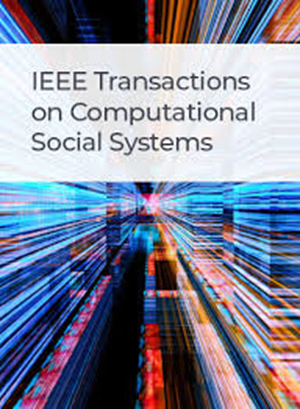多视图聚类的深度相似图融合
IF 4.5
2区 计算机科学
Q1 COMPUTER SCIENCE, CYBERNETICS
IEEE Transactions on Computational Social Systems
Pub Date : 2024-10-30
DOI:10.1109/TCSS.2024.3479188
引用次数: 0
摘要
基于图的多视图聚类由于能够有效地表示多视图数据之间的复杂关系,从而得到了广泛的关注。在以往的基于图的方法中,多视图图学习(或图融合)技术迅速成为一个有前途的方向,然而,它仍然存在两个关键的局限性。首先,以往的方法大多采用单级图融合,缺乏从单级图融合到多级(深度)图融合的能力。其次,它们通常侧重于构建一个最优的统一图,而不能充分研究多个视图之间的相关性。因此,很难建立一个全面而明显的图结构。鉴于此,本文针对多视图聚类任务提出了一种新的多视图图学习方法,称为深度相似图融合(DSGF),该方法同时利用三条路径将多层相似度融合成一个统一的图。其中,利用多层图融合为每个视图获取特定视图的相似图,然后将这些单视图图(通过三层图融合)融合成一个鲁棒图,利用了各种相似图之间更深层次的一致性信息,提高了学习图的质量,为最终的谱聚类过程提供了条件。在六个真实的多视图数据集上进行了大量的实验,与最先进的方法相比,DSGF的聚类性能具有很强的竞争力。本文章由计算机程序翻译,如有差异,请以英文原文为准。
Deep Similarity Graph Fusion for Multiview Clustering
The graph-based multiview clustering has gained significant attention due to its effectiveness in representing complex relationships among multiview data for enhanced clustering. Among the previous graph-based methods, the multiview graph learning (or graph fusion) technique has rapidly emerged as a promising direction, which, however, still suffers from two critical limitations. First, most of previous methods adopt a single-level of graph fusion, which lack the ability to go from single-level graph fusion to multilevel (deep) graph fusion. Second, they generally focus on constructing an optimal unified graph but cannot fully investigate the correlations among multiple views. Therefore, it is difficult to establish a comprehensive and obvious graph structure. In light of this, this article presents a new multiview graph learning method called deep similarity graph fusion (DSGF) for the multiview clustering task, where three pathways are simultaneously leveraged to fuse multilevel similarity into a unified graph. Particularly, multilevel graph fusion is utilized to obtain a view-specific similarity graph for each view and then fuse these single-view graphs (via three levels of graph fusion) into a robust graph, which takes advantage of deeper consensus information between various similarity graphs and improves the quality of the learned graph for the final spectral clustering process. Extensive experiments are conducted on six real-world multiview datasets, which demonstrate the highly competitive clustering performance of DSGF in comparison with state-of-the-art methods.
求助全文
通过发布文献求助,成功后即可免费获取论文全文。
去求助
来源期刊

IEEE Transactions on Computational Social Systems
Social Sciences-Social Sciences (miscellaneous)
CiteScore
10.00
自引率
20.00%
发文量
316
期刊介绍:
IEEE Transactions on Computational Social Systems focuses on such topics as modeling, simulation, analysis and understanding of social systems from the quantitative and/or computational perspective. "Systems" include man-man, man-machine and machine-machine organizations and adversarial situations as well as social media structures and their dynamics. More specifically, the proposed transactions publishes articles on modeling the dynamics of social systems, methodologies for incorporating and representing socio-cultural and behavioral aspects in computational modeling, analysis of social system behavior and structure, and paradigms for social systems modeling and simulation. The journal also features articles on social network dynamics, social intelligence and cognition, social systems design and architectures, socio-cultural modeling and representation, and computational behavior modeling, and their applications.
 求助内容:
求助内容: 应助结果提醒方式:
应助结果提醒方式:


